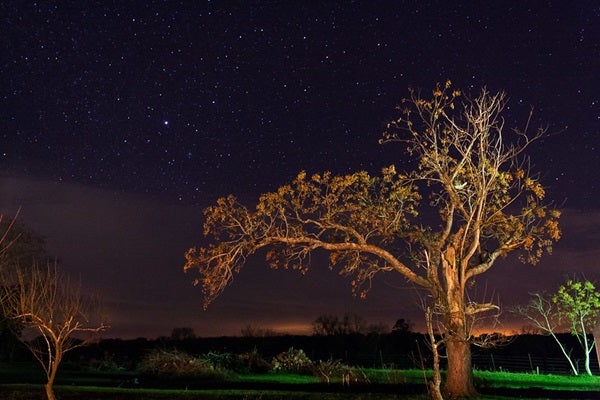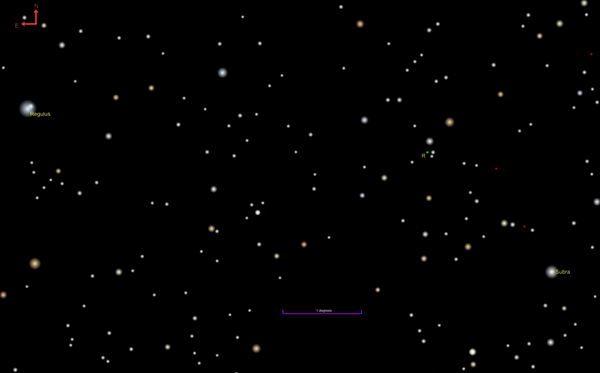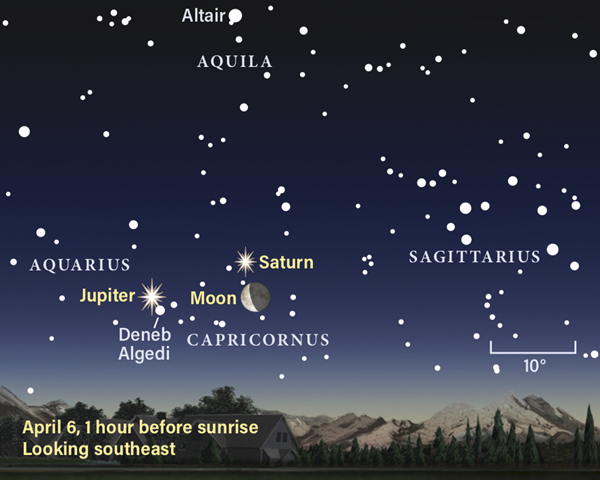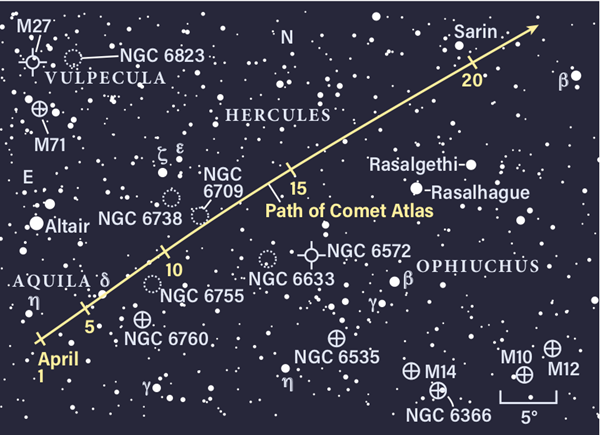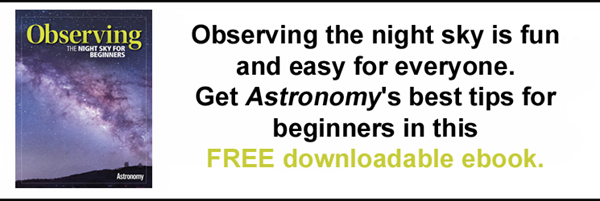Friday, April 2
The constellation Leo is already high in the eastern sky at sunset. About an hour later, begin looking for R Leonis, the Lion’s first identified variable star and April’s AAVSO featured variable star of the month. You’ll find it about 5.1° west-southwest of bright (magnitude 1.4) Regulus or 2.2° northeast of magnitude 3.5 Subra. With binoculars or a telescope, R Leonis will appear as the ruby-colored tip of a triangle, with two yellow stars (magnitude 9 and 10) to its southwest, forming the base.
R Leonis is a cool red giant star nearing the end of its life. It is characterized as a long-period variable, much like the more famous Mira in Cetus. Its magnitude fluctuates between 5 and 10.5 over the course of about 312 days, so the star may be difficult to see if it’s near its minimum magnitude. But keep watching — over time, you’ll see this crimson star “reappear” in the sky as it brightens once more.
Sunrise: 6:42 A.M.
Sunset: 7:26 P.M.
Moonrise: 12:31 A.M.
Moonset: 10:04 A.M.
Moon Phase: Waning gibbous (69%)
*Times for sunrise, sunset, moonrise, and moonset are given in local time from 40° N 90° W. The Moon’s illumination is given at 12 P.M. local time from the same location.
Saturday, April 3
Magnitude 5.7 M5 is the brightest globular cluster in the Northern Hemisphere. You can find it in the constellation Serpens after it clears the horizon around 9:30 P.M. local time and climbs higher as the night progresses. Fortunately, there’s no Moon yet.
Look 11.5° due north of magnitude 2.6 Zubenesch (Beta [β] Librae) to find M5, which actually sits 24,500 light-years away. If you’re in a dark location, you may spot a fuzzy patch without optical aid. Binoculars or a telescope will definitely make this ancient grouping of stars easier to locate. Through even a small instrument, you’ll see the cluster’s “grainy” nature. And the larger your scope, the more cluster stars you’ll see. (In fact, William Herschel was the first to resolve M5 into stars in 1791, although it had been discovered earlier that same century.)
Sunrise: 6:40 A.M.
Sunset: 7:27 P.M.
Moonrise: 1:42 A.M.
Moonset: 10:57 A.M.
Moon Phase: Waning gibbous (58%)
Sunday, April 4
Last Quarter Moon occurs today at 6:02 A.M. EDT. Two hours later, asteroid 9 Metis reaches opposition at 8 A.M. EDT in the constellation Virgo. Early risers can find the magnitude 10 asteroid about 3.4° southeast of Auva (Delta [δ] Virginis).
For those who celebrate Easter, there’s an Easter Rabbit waiting in the sky for you tonight. After sunset, look southwest to spot the stars of the constellation Lepus the Hare, who sits at the feet of Orion the Hunter. The Hare contains about a dozen easily visible stars scattered over 290 square degrees, or 0.7 percent of the sky. Its brightest stars are magnitude 2.6 Arneb and magnitude 2.9 Nihal.
To find Lepus, locate magnitude –1.4 Sirius, the Northern Hemisphere’s brightest star. Lepus lies due west of this star and due south of a line connecting Orion’s knees (Rigel and Saiph). The Hare contains one Messier object: magnitude 7.7 globular cluster M79, easily visible with binoculars or a small scope. You’ll find it 3.5° south-southwest of Nihal.
Sunrise: 6:39 A.M.
Sunset: 7:28 P.M.
Moonrise: 2:43 A.M.
Moonset: 11:57 A.M.
Moon Phase: Last Quarter
Monday, April 5
Saturn’s largest and brightest moon, Titan, passes due south of the ringed planet today, although the event occurs during daylight hours in North America. Two hours before sunrise, Saturn is already nearly 6° high and rising in Capricornus the Sea Goat. The Moon, now roughly 40 percent lit, lies nearly 14° to its southwest, just over the border in Sagittarius. Our satellite will pass close to Saturn tomorrow morning.
Magnitude 8.8 Titan currently sits about 54″ southeast of the planet. Over the next several hours, it will progress west until it passes due south of the planet. Smaller moons Rhea, Tethys, and Dione may also be easily visible, closer to Saturn’s rings. Mimas and Enceladus also float nearby, while Iapetus lies a considerable 5.5′ to the planet’s west.
Sunrise: 6:37 A.M.
Sunset: 7:29 P.M.
Moonrise: 3:36 A.M.
Moonset: 1:01 P.M.
Moon Phase: Waning crescent (36%)
Tuesday, April 6
The Moon passes 4° south of magnitude 0.6 Saturn at 4 A.M. EDT. It then continues on, headed for a similar rendezvous with Jupiter tomorrow morning.
If you’re up early to admire the pairing, also take some time to turn your gaze south, where Scorpius is fully visible above the horizon. One of the constellations that most resembles its namesake, the Scorpion’s long, curved tail sits closer to the ground, while his claws are highest in the sky. His heart is marked by Antares, a red supergiant star shining at magnitude 1. This “rival of Mars” is often mistaken for the Red Planet, thanks to its brightness and color, although Mars itself is not visible this morning (it is currently an evening object).
Like Betelgeuse, Antares is an elderly star with enough mass to someday explode as a supernova that would be quite visible — and quite brilliant — from Earth.
Sunrise: 6:35 A.M.
Sunset: 7:30 P.M.
Moonrise: 4:18 A.M.
Moonset: 2:07 P.M.
Moon Phase: Waning crescent (27%)
Wednesday, April 7
Dwarf planet Ceres — the largest object in the asteroid belt and one of the worlds visited by the Dawn spacecraft — is in conjunction with the Sun at 3 A.M. EDT.
Since passing by Saturn yesterday, the waning crescent Moon has slid east and passes 4° south of Jupiter at 3 A.M. EDT. Jupiter, currently a bright magnitude –2.1, rises first around 4:30 A.M. local time. The Moon follows about 25 minutes later. Jupiter is surrounded by its Galilean moons: To the east sit Ganymede (farthest) and Io (nearest); to the west are Europa (nearest) and Callisto (farthest).
This morning, Jupiter also sits 2° due north of magnitude 2.9 Deneb Algedi (Delta Capricorni). This white, A-type star sits nearly 40 light-years away and is part of a multiple-star system containing three other stars. One of those companions has an orbit that carries it in front of the bright star about once a day. During these eclipses, Deneb Algedi dims by roughly 0.2 magnitude, which is enough to notice with the naked eye — if an observer is meticulous in recording its brightness compared to nearby stars.
Sunrise: 6:34 A.M.
Sunset: 7:31 P.M.
Moonrise: 4:54 A.M.
Moonset: 3:13 P.M.
Moon Phase: Waning crescent (18%)
Thursday, April 8
Early this morning before sunrise, you’ll find Comet C/2020 R4 (ATLAS) amid the plane of the Milky Way in Aquila. The comet, which is roughly magnitude 10, is less than 7′ due east of magnitude 5.6 22 Aquilae. Nearby — just 2.1° west of the comet’s position — is the magnitude 13.5 open cluster NGC 6755, which spans roughly 6′ on the sky. Twice that distance to the comet’s south is the brighter (magnitude 9) globular NGC 6760, which is slightly more compact at about 5.4′ across.
ATLAS will continue through a region rich with deep-sky objects all month, so keep an eye on this visitor from the Kuiper Belt for more cosmic meetups throughout April. The comet makes its closest approach to Earth on the 23rd, when it will be roughly half the average Earth-Sun distance from our planet. After that, its brightness will diminish quickly. You’ll want to get in your observations now — once ATLAS fades from view, it won’t return for another 933 years.
Sunrise: 6:32 A.M.
Sunset: 7:32 P.M.
Moonrise: 5:24 A.M.
Moonset: 4:16 P.M.
Moon Phase: Waning crescent (11%)
Friday, April 9
The Moon passes 4° south of Neptune at 7 A.M. EDT. Catching the pair will be a bit of a challenge — your best bet is to look east about half an hour before sunrise, where Neptune and a thin crescent Moon lie in eastern Aquarius. At that time, Neptune is just 5° high, with the Moon a mere 1° above the horizon.
Neptune is now magnitude 7.8; you should be able to spot it in the brightening twilight with binoculars, but take care to put them away several minutes before sunrise. The ice giant passed through superior conjunction last month and now sits nearly 5° east of 4th magnitude Phi (ϕ) Aquarii. The star and planet will get easier to spot as the month wears on, rising earlier with each passing day and ultimately climbing more than 10° above the horizon by 5:30 A.M. local time by April’s end.
Sunrise: 6:31 A.M.
Sunset: 7:33 P.M.
Moonrise: 5:50 A.M.
Moonset: 5:18 P.M.
Moon Phase: Waning crescent (6%)

